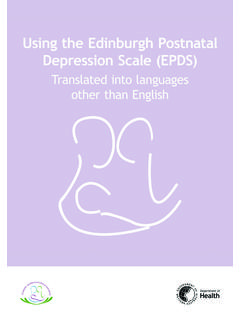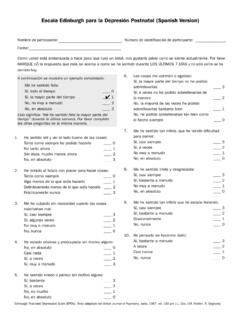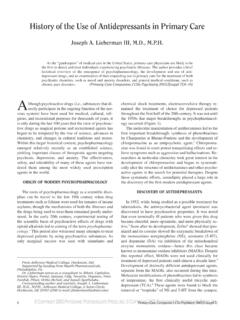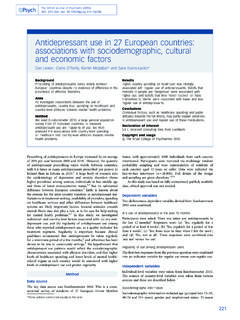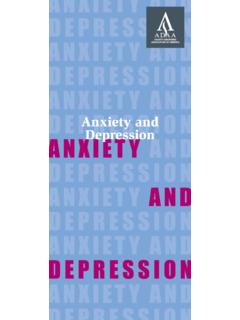Transcription of Review Antidepressant use in pregnancy: a critical review ...
1 ReviewAntidepressant use in pregnancy : a criticalreview focused on risks and controversiesByatt N, Deligiannidis KM, Freeman MP. Antidepressant use inpregnancy: a critical Review focused on risks and :Conflicting data have led to controversy regardingantidepressant use during pregnancy . The objectives of this study are toi) Review the risks of untreated depression and anxiety, ii) Review theliterature on risks of exposure to antidepressants during pregnancy , iii)discuss the strengths and weaknesses of the different study designs usedto evaluate those risks, and iv) provide clinical :MEDLINE/PubMed was searched for reports and studies onthe risk of first-trimester teratogenicity, postnatal adaptation syndrome(PNAS), and persistent pulmonary hypertension (PPHN) with in uteroantidepressant :While some individual studies suggest associations betweensome specific major malformations, the findings are , the absolute risks appear small.
2 PNAS occurs in up to 30%of neonates exposed to antidepressants. In some studies, PPHN hasbeen weakly associated with in utero Antidepressant exposure, while inother studies, there has been no :Exposures of concern include that of untreated maternalillness as well as medication exposure. It is vital to have a carefuldiscussion, tailored to each patient, which incorporates the evidence todate and considers methodological and statistical limitations. Pastmedication trials, previous success with symptom remission, andwomen s preference should guide treatment Byatt1, K. M. Deligiannidis2,M. P. Freeman31 Psychiatry and Obstetrics & Gynecology, PsychosomaticMedicine, Women s Mental Health, University ofMassachusetts Medical School/UMass MemorialMedical Center, Worcester, MA, USA,2 Psychiatry andObstetrics & Gynecology, Depression Specialty Clinic,Women s Mental Health Specialty Clinic, Center forPsychopharmacologic Research and Treatment,University of Massachusetts Medical School/UMassMemorial Medical Center, Worcester, MA, USA and3 Psychiatry, Perinatal and Reproductive PsychiatryProgram, Harvard Medical School/MassachusettsGeneral Hospital, Boston, MA, USAKey words: Antidepressant ; in utero; teratogenicity;postnatal adaptation syndrome.
3 Persistent pulmonaryhypertensionNancy Byatt, Psychiatry and Obstetrics & Gynecology,Psychosomatic Medicine, Women s Mental Health,University of Massachusetts Medical School/UMassMemorial Medical Center, 55 Lake Avenue North,Worcester, MA 01655, : for publication October 10, 2012 Summations No single type of malformation has been consistently observed across studies with any commonlyused Antidepressant . Some individual studies suggest associations between particular selective seroto-nin reuptake inhibitors (SSRIs) and specific birth defects. Postnatal adaptation syndrome (PNAS) occurs in up to 30% of neonates exposed to antidepressantsin late pregnancy . Some studies find a small association between persistent pulmonary hypertension of the newborn(PPHN) and SSRI use, although other studies do SSRIs remain the most studied antidepressants in pregnancy .
4 Less data are available for serotonin norepinephrine reuptake inhibitors (SNRIs), mirtazapine, nefazodone, trazodone and vilazodone. The current evidence base is limited by data that do not i) systematically assess infants, ii) use appro-priate control groups, iii) use blind raters of the neonates and iv) take into account maternal diagno-sis or symptoms or other confounding variables. The evidence regarding the risk of PPHN because of in utero Antidepressant exposure is Psychiatr Scand 2013: 127: 94 114 2012 John Wiley & Sons A/S. Published by Blackwell Publishing LtdAll rights reservedDOI: PSYCHIATRICA SCANDINAVICAI ntroductionDuring the reproductive years, a significant pro-portion of women experienced depressive and anx-iety disorders (1). Approximately of womensuffer from antenatal depression, and as many of mothers develop a depressive disorderwithin several weeks of delivery (2).
5 Anxiety disor-ders are also common, with a prevalence rate during the 3rd trimester of pregnancy , during the first 3 postpartum months (3, 4).Untreated depression and anxiety during preg-nancy negatively impacts mother and are more likely to experience inadequatematernal weight gain (5) and abuse substances (6).Depression in pregnancy is also associated withpreeclampsia, preterm birth (7 10), increased riskfor delivery of a low birth weight infant (11), elec-tive termination of the pregnancy (12), postpartumdepression (13), and anxiety. Depression is associ-ated with fetal distress (14) and an increased riskof neonatal care unit admission and caesariandelivery (15).Postpartum depression can negatively impactchild development and has been associated withdifficult infant and childhood temperament (16,17) and attachment insecurity (16).
6 Maternaldepression may also lead to emotional and func-tional disability in children including cognitivedelays (18), behavioural problems (16), and diffi-culties with social interaction (19). Children ofdepressed mothers are at increased risk of develop-mental delay, impaired language development, andlower IQ scores (20, 21). The impact of maternaldepression has effects beyond infancy, as one-thirdof school-aged children of depressed mothers suf-fer from depressive, anxiety, or disruptive disor-ders (22). Effective treatment of maternaldepression mitigates this negative impact (23).Perinatal depression can also be fatal; maternalsuicide accounts for up to 20% of postpartumdeaths in depressed women (24).Stress and anxiety during pregnancy influencematernal behaviour and birth outcomes: maternaltobacco smoking, caffeine consumption, poornutrition and exercise, preterm labor, pretermbirth, and low birth weight are associated with pre-natal anxiety (25).
7 Antenatal anxiety may increasethe risk of childhood developmental and psychiat-ric disorders. It may adversely affect infant emo-tional development (26) and has been associatedwith reductions in gray matter density in youngchildren (27). Treatment of perinatal depressiveand anxiety disorders is of paramount importanceto mitigate these risks. Despite the risk of relapseto depressive episodes and anxiety and associatedadverse effects, women are likely to stop antide-pressant treatment during attempts to conceive orpregnancy (28, 29).Due to conflicting reports in the literature on therisk of first-trimester teratogenicity, postnataladaptation syndrome (PNAS), and persistent pul-monary hypertension (PPHN) with in utero anti-depressant exposure, a Review of these topics is ofgreat clinical importance.
8 In this Review , selectedtopics of controversy regarding Antidepressant usein pregnancy are presented, to provide clarificationduring clinical decision-making and risk/benefitassessment and discussion. A Review of all possibleoutcomes is beyond the scope of this not reviewed in this article, there areassociations between Antidepressant in utero expo-sure and measures of birth outcome, including anincreased rate of spontaneous abortion (30 35)(36 39), low birth weight (35, 40, 41), and reducedgestational age or preterm birth (35, 40, 42 44) indepressed women exposed to studies have raised questions about possi-ble associations with Antidepressant use inpregnancy, including autism (45) and effects onlong-term neurocognitive development (46). Whileall associations with in utero exposure are impor-tant, we limited our Review to topics that havebecome the main controversies in antidepressantuse during pregnancy in recent of the studyThe purposes of this Review are to i) Review therisks of untreated depression and anxiety, ii) Review the literature on risks of exposure to com-monly used antidepressants during pregnancy , iii)discuss the strengths and weaknesses of the differ-ent study designs used to evaluate those risks, andiv) provide clinical and methodsA search was performed for the English languageliterature indexed on MEDLINE/PubMed for theperiod between 1966 and 2012 using the followingkey terms.
9 Antidepressant , selective serotonin reup-take inhibitor (SSRI), serotonin-norepinephrinereuptake inhibitor (SNRI), noradrenergic and spe-cific serotonin Antidepressant (NaSSA), norepi-nephrine reuptake inhibitor (NRI), fluoxetine,paroxetine, sertraline, citalopram, escitalopram,fluvoxamine, venlafaxine, mirtazapine, reboxetine,duloxetine, bupropion, trazodone, nefazodone,and vilazodone in association with antenataldepression, maternal, pregnancy , prenatal expo-sure, malformation, in utero exposure, neonatal95 Antidepressant use in pregnancycomplications, gestational, neonatal health, neona-tal outcome, birth outcome, PPHN, birth defects,and congenital heart defect. To determine whetherother relevant articles were not identified in the ini-tial search, all articles were cross-referenced.
10 Origi-nal observational studies, case reports, and caseseries were exposure: is there evidence of teratogenicity?In the USA, approximately 1 in every 33 infants(3%) is born with a major birth defect (47). Majorbirth defects or malformations typically requiremedical or surgical intervention for a structural orfunctional abnormality. Antidepressants that affectserotonergic tone could putatively increase theincidence of congenital malformations becauseserotonin is important in aspects of early embry-onic development that impact development of theneural tube, branchial arch, and the high prevalence of birth defectsoverall in the population, each specific type ofmajor birth defect is generally rare, and studiesthat are inadequately powered or controlled mayoverestimate risk and association.
